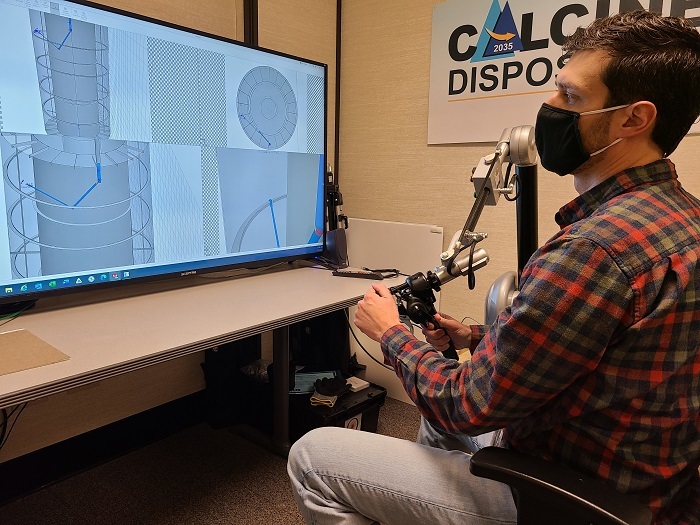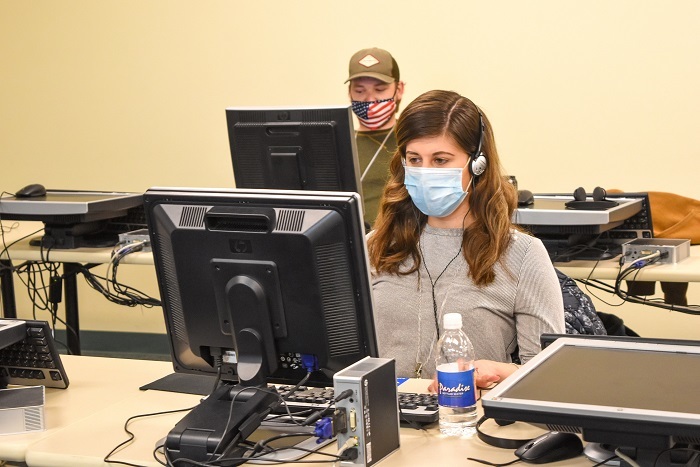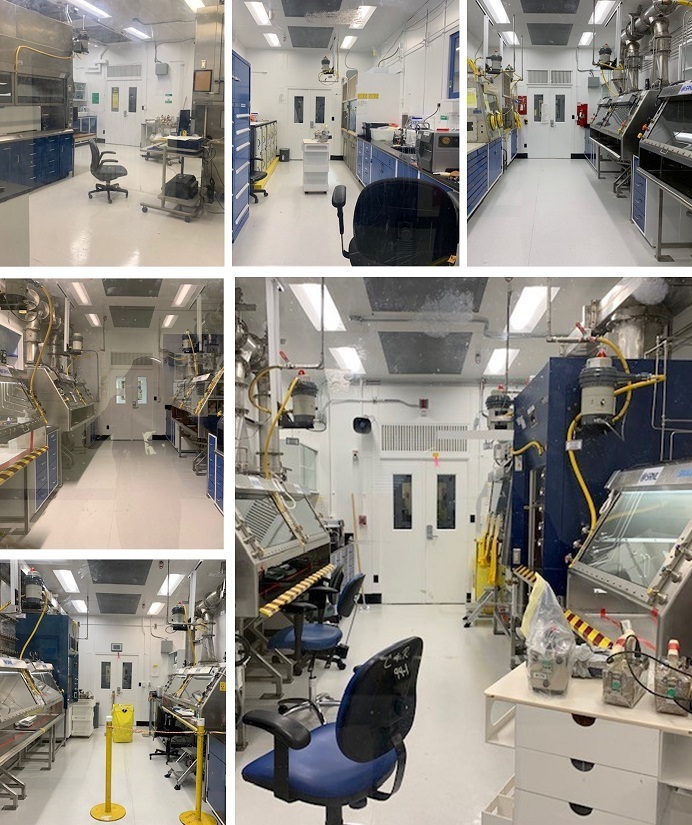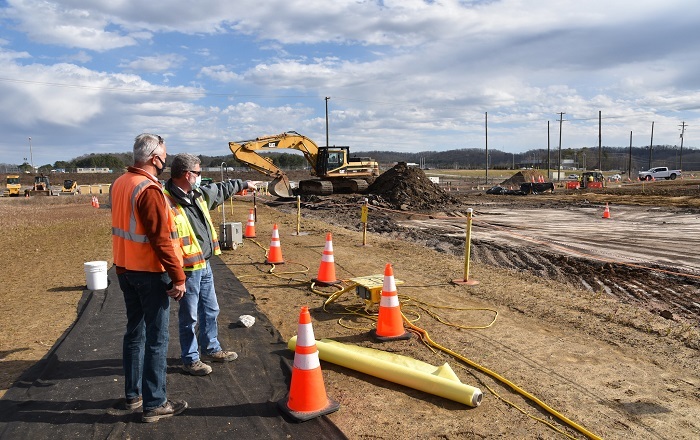 Idaho National Laboratory Site Calcine Retrieval Project Design Engineer Derek Allen tests a robotic arm and related software that uses haptic feedback in advance of full-scale testing.
IDAHO FALLS, Idaho – An EM project at the Idaho National Laboratory Site is using robotic technology and taking cues from the smartphone and gaming industries to increase the dexterity of equipment operators.
The calcine retrieval project recently purchased and began testing a robotic arm and digital control system that uses haptic feedback to allow operators to “feel” the metal walls and other intrusions of high-level waste tanks.
Smartphone users feel haptic feedback when they receive text messages. Gamers feel haptic feedback when they use controllers that vibrate to create a sense of realism in first-person games. The feedback can come in the form of force, vibrations, movement, or a combination of the three transmitted to the operator.
Last summer, engineers began testing a robotic arm in a mock-up of one of the project’s high-level radioactive waste storage tanks known as bin sets. The robotic arm was used to direct simulated dry calcine waste toward a retrieval system, but the operators of the arm had no depth perception and limited visibility in the 20-foot-long tank. As a result, they often slammed the robotic arm into the tank walls.
“In many respects, our operators were flying blind,” Fluor Idaho Calcine Retrieval Project Manager Howard Forsythe said. “Once the simulated calcine was airborne in the tank, it was virtually impossible to see even with an array of cameras.”
The haptic feedback technology allows the operators to feel the forces the robot is experiencing, making the controls feel more natural and letting the operators feel their way through the environment.
Another component of the technology is a digital twin, which is a computer-generated version of the arm displayed on a screen. The digital twin will mimic in real-time the movements of the physical arm so the operator can see how the arm is positioned within the calcine storage bin, even when the bin becomes too cloudy for the camera system.
The project is also using a six-axis robotic arm that allows the operator to control the position of the end of the arm while it determines the required joint angles to achieve the desired position. The internal motors of the arm allow it to resist movements from the operator if the arm is colliding with a wall or has reached a physical joint limitation.
The control system is also capable of running in simulation mode, in which the operator is directly controlling the digital twin and not the physical arm, allowing the operator to practice prior to controlling the physical arm. The testing so far has taken place in simulation mode, while integration and testing with the physical arm is anticipated for early this summer.
The calcine retrieval project will retrieve 220 cubic meters of calcine from one bin set and transfer it to another bin set. The first bin set would then be closed under federal regulations.
-Contributor: Erik Simpson
 Bernice Bunker and Justin Korenkiewicz are two of approximately 50 laboratory and radiological technicians EM Office of River Protection contractor Bechtel National, Inc. plans to hire and train this year to prepare the Analytical Laboratory at Hanford’s Waste Treatment and Immobilization Plant for cold commissioning.
RICHLAND, Wash. – EM Office of River Protection (ORP) contractor Bechtel National, Inc. (BNI) is hiring and training dozens of laboratory and radiological technicians to prepare for cold commissioning of Hanford’s Waste Treatment and Immobilization Plant, when operators will run a non-radioactive waste simulant through the plant to ensure systems are working properly.
The first class of 12 new laboratory technicians is in training. They join chemists hired last year and together will be responsible for analyzing approximately 3,000 samples of tank waste at the plant’s Analytical Laboratory each year to support Direct-Feed Low-Activity Waste (DFLAW) operations. DFLAW is a system of interdependent projects and infrastructure improvements, managed and highly integrated as a program, that must operate together to vitrify, or immobilize within glass, Hanford tank waste.
“The waste in the tanks is very complex, and each batch of waste fed to the plant’s Low-Activity Waste Facility must be sampled and analyzed to ensure the vitrified end product meets regulatory standards,” said Mat Irwin, ORP deputy assistant manager for the plant.
Fourteen lab spaces will be used to conduct analyses of the elements within the waste, as well as determine physical and chemical properties of waste. The results will determine the type and amount of glass-forming materials that will be mixed with batches of tank waste during vitrification. Samples will also be taken throughout the vitrification process to confirm the plant is producing high-quality glass.
Last month, EM and BNI declared the lab “ready to operate” after safely constructing and testing all systems in the laboratory. The class of 12 new technicians is the latest wave of new hires as the plant transitions to commissioning work prior to operations.
“We expect to have 45 staff working 24/7 shifts in the Analytical Laboratory when DFLAW operations begin,” said Valerie McCain, Bechtel senior vice president and project director. “A second set of 12 lab technicians and 20 radiological technicians will be hired later this spring for commissioning and operations roles.”
-Contributor: Staci A. West
 The Savannah River National Laboratory Modifications Team has reached a milestone of shuttering F/H Analytical Laboratory and transitioning activities and staff to new facilities, pictured here, at the Savannah River Site.
AIKEN, S.C. – Savannah River National Laboratory (SRNL) has successfully consolidated a laboratory that has provided vital analytical results to support almost every critical mission of the Savannah River Site over the last 60 years. The effort will provide future cost savings of more than $20 million.
As part of an effort to close legacy facilities in a portion of the site known as F Area, SRNL and Savannah River Nuclear Solutions (SRNS), the site’s management and operations contractor, began a phased approach in 2015 to close the F/H Analytical Laboratory and relocate the lab’s capabilities, programs, and personnel to SRNL’s main campus in A Area.
The final phase of that effort, which started in late fiscal 2018, included lab modifications in the main campus facility. The project was completed early despite the COVID-19 pandemic and competing SRNL priorities.
“The consolidation of F/H Laboratory services has been completed safely in support of the site’s mission to save millions of dollars annually in both facility and analytical cost,” said Woodie Melton, director of analytical characterization at SRNS. “With the establishment of new laboratories and added analytical methods and personnel, the future of SRNL analytical capabilities is stronger and is prepared to generate additional scientific discoveries, aiding in solving problems for both current and future DOE missions.”
Future analytical capabilities being established include a laboratory for high-precision isotopic measurements and added capabilities to dissolve and prepare plutonium oxide samples for analytical characterization.
“I am very proud of SRNL’s efforts to consolidate our analytical methods in A Area,” said Vahid Majidi, SRNS executive vice president and SRNL director. “This was a significant undertaking on the part of many and will allow us to provide the highest quality analytical services to all of our customers.”
 An emerging issues team that’s part of a regulatory partnership framework focused on the Oak Ridge EM program’s cleanup helped obtain early approvals for soil removal projects, allowing effective use of the available workforce and funding.
OAK RIDGE, Tenn. – DOE’s Oak Ridge Office of Environmental Management (OREM) and contractor UCOR are attributing acceleration of several cleanup projects to a new regulatory partnership framework that marked its first anniversary in February.
OREM and UCOR leadership formed the framework to aid decision-making and approvals needed to conduct cleanup operations at the Oak Ridge National Laboratory (ORNL) and Y-12 National Security Complex (Y-12) following the Oak Ridge EM program’s historic cleanup accomplishments at the East Tennessee Technology Park. They also envision the arrangement potentially serving as a model for other cleanup sites across the DOE complex.
“As we looked ahead to major cleanup at the Oak Ridge National Laboratory and the Y-12 National Security Complex, we took the opportunity to improve partnering and enhance the process for how we solve regulatory challenges collaboratively,” OREM Manager Jay Mullis said.
Members of the framework represent OREM, UCOR, the U.S. Environmental Protection Agency (EPA), and the Tennessee Department of Environment and Conservation (TDEC). Management representatives serve on an emerging issues team and project management representatives serve on a project team. These teams are working to resolve regulatory challenges and improve communication so the agencies can make protective, timely cleanup decisions.
“Our vision was to empower the emerging issues team to resolve issues that were preventing the project team from completing efforts. We are pleased with the success this approach is having,” TDEC Deputy Commissioner Greg Young said.
In the first months of the framework, the emerging issues team resolved several longstanding issues and expedited approvals for soil removal projects, allowing effective use of the available workforce and funding.
The project team resolved comments on a section of an upcoming draft record of decision for the site’s planned Environmental Management Disposal Facility. That document is crucial in the approval process for the facility, which will provide onsite waste disposal capacity for lower activity level waste generated from ORNL and Y-12 cleanup.
“This has been a tremendous success story that has allowed us to strengthen relationships with our regulatory agencies and collaboratively find solutions to issues,” UCOR President Ken Rueter said. “It’s been remarkable also to pull this off while facing the extra challenge of meeting virtually due to the COVID-19 pandemic.”
The teams continue to identify and resolve issues and create strategies to best support cleanup pace.
“This effort markedly improves communication and problem solving and fosters our mutual goal of furthering the quality and pace of cleanup. The emerging issues team and leadership team are actively identifying and resolving technical and regulatory hurdles that may otherwise impede cleanup progress,” Acting EPA Deputy Regional Administrator Carol Monell said. “EPA appreciates the dedication of the team and looks forward to continued partnership.”
-Contributor: Roger Petrie
 Workers at the West Valley Demonstration Project install a long-reach arm on a large excavator that will be used for the demolition of the Main Plant Process Building.
WEST VALLEY, N.Y. – EM and cleanup contractor CH2M HILL BWXT West Valley (CHBWV) recently installed a long-reach arm on an excavator for ease of access in the demolition of the Main Plant Process Building at the West Valley Demonstration Project (WVDP).
The new arm extends the excavator’s reach from 50 feet to 86 feet, allowing the operator to get to the plant’s highest point of 79 feet. Crews also added a new tilt cab to the excavator to improve the operator’s view when performing high-reach work.
“Planning and preparations for Main Plant demolition have been going on for two decades,” EM WVDP Director Bryan Bower said. “Procuring demolition and support equipment for this work scope is an important element in our success; and these upgrades will make sure this piece of equipment continues to perform its intended function.”
 |
|
Crews install a new tilt cab in an excavator that will improve the operator’s view when performing high-reach work in the demolition of the Main Plant Process Building at the West Valley Demonstration Project. |
The excavator was used in the successful takedown of the 10,000-square-foot Vitrification Facility and other support structures surrounding the Main Plant.
“When performing any work, it’s important to have the right equipment to do the job safely and compliantly,” CHBWV Facility Disposition Operations Manager Scott Chase said. “The modifications we’ve done will further improve its capability to demolish the Main Plant safely, efficiently, and compliantly.”
-Contributor: Joseph Pillittere
|